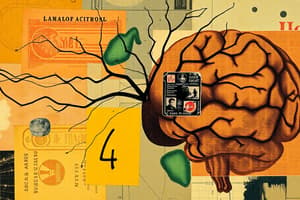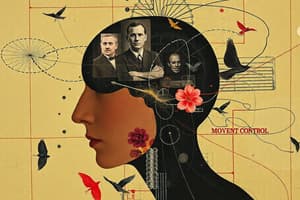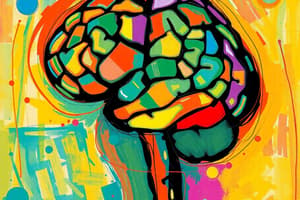Podcast
Questions and Answers
The basal ganglia continuously send feedback to the cortex to ensure the correct sequence of movements is being performed.
The basal ganglia continuously send feedback to the cortex to ensure the correct sequence of movements is being performed.
True (A)
The basal ganglia verify if the ongoing motor act matches the stored pattern for that specific act.
The basal ganglia verify if the ongoing motor act matches the stored pattern for that specific act.
True (A)
The basal ganglia only receive input from the cerebral cortex during motor act execution.
The basal ganglia only receive input from the cerebral cortex during motor act execution.
False (B)
Information from the basal ganglia can modify the motor final common pathway, even before the activation of motoneurons.
Information from the basal ganglia can modify the motor final common pathway, even before the activation of motoneurons.
The basal ganglia can't influence movements that are not stored in the memory.
The basal ganglia can't influence movements that are not stored in the memory.
The basal ganglia receive information from the motor and sensory cortex, but not from other brain nuclei.
The basal ganglia receive information from the motor and sensory cortex, but not from other brain nuclei.
The basal ganglia exclusively control the activation of motoneurons in the spinal cord.
The basal ganglia exclusively control the activation of motoneurons in the spinal cord.
The information delivered to the basal ganglia is solely used to confirm the accuracy of the performed movement.
The information delivered to the basal ganglia is solely used to confirm the accuracy of the performed movement.
The basal ganglia only play a role in motor control, not in other cognitive functions.
The basal ganglia only play a role in motor control, not in other cognitive functions.
The influence of the basal ganglia on the motor act is limited to the initial stages of the movement.
The influence of the basal ganglia on the motor act is limited to the initial stages of the movement.
The dento-thalamo-cortical tract is primarily formed by the feedback from the cerebellum to the spinal cord.
The dento-thalamo-cortical tract is primarily formed by the feedback from the cerebellum to the spinal cord.
The retrolentiform limb of the internal capsule primarily carries the acoustic ascending pathways.
The retrolentiform limb of the internal capsule primarily carries the acoustic ascending pathways.
Arnold's bundle passes through the posterior limb of the internal capsule to correlate with the temporal lobe.
Arnold's bundle passes through the posterior limb of the internal capsule to correlate with the temporal lobe.
The corticospinal tract is located in the genu of the internal capsule.
The corticospinal tract is located in the genu of the internal capsule.
Fibres correlating to the parietal lobe travel through the anterior limb of the internal capsule.
Fibres correlating to the parietal lobe travel through the anterior limb of the internal capsule.
The claustrum is located medial to the putamen.
The claustrum is located medial to the putamen.
The amygdala is connected to the tail of the caudate nucleus and the fornix.
The amygdala is connected to the tail of the caudate nucleus and the fornix.
The lentiform nucleus is positioned posterior to the thalamus in an anteroposterior orientation.
The lentiform nucleus is positioned posterior to the thalamus in an anteroposterior orientation.
The external capsule is thicker than the extreme capsule.
The external capsule is thicker than the extreme capsule.
The insular lobe is completely visible due to its superficial location.
The insular lobe is completely visible due to its superficial location.
The claustrum has no known anatomical relationships with surrounding structures.
The claustrum has no known anatomical relationships with surrounding structures.
The tail of the caudate turns inferiorly around the lentiform nucleus.
The tail of the caudate turns inferiorly around the lentiform nucleus.
The internal capsule has a longer anterior limb compared to the posterior limb.
The internal capsule has a longer anterior limb compared to the posterior limb.
The genu of the internal capsule is located between the head of the caudate and the anterior portion of the thalamus.
The genu of the internal capsule is located between the head of the caudate and the anterior portion of the thalamus.
The optic radiation is contained within the anterior limb of the internal capsule.
The optic radiation is contained within the anterior limb of the internal capsule.
The amygdala has a corticomedial region that is primarily connected to the olfactory bulb.
The amygdala has a corticomedial region that is primarily connected to the olfactory bulb.
The ventrolateral region of the amygdala is associated exclusively with memory functions.
The ventrolateral region of the amygdala is associated exclusively with memory functions.
The limbic system has no role in the processing of unconscious information.
The limbic system has no role in the processing of unconscious information.
The retrolentiform limb of the internal capsule emerges from the anterior aspect of the thalamus.
The retrolentiform limb of the internal capsule emerges from the anterior aspect of the thalamus.
The thalamus participates in the regulation of emotional status within the limbic system.
The thalamus participates in the regulation of emotional status within the limbic system.
The caudate nucleus is entirely visible in a horizontal section viewed from a superior perspective.
The caudate nucleus is entirely visible in a horizontal section viewed from a superior perspective.
The subthalamus does not send any information back to the corpus striatum.
The subthalamus does not send any information back to the corpus striatum.
The main efferent fibres from the substantia nigra project to the thalamus to communicate with the spinal cord.
The main efferent fibres from the substantia nigra project to the thalamus to communicate with the spinal cord.
The corpus striatum receives input primarily from sensory areas of the cortex.
The corpus striatum receives input primarily from sensory areas of the cortex.
Pallidofugal fibres originate from the globus pallidus internus.
Pallidofugal fibres originate from the globus pallidus internus.
The uncertain zone is a definitive region of the brain with well-understood functions.
The uncertain zone is a definitive region of the brain with well-understood functions.
The ventral anterior (VA) and ventrolateral (VL) are specific nuclei involved in thalamic projections.
The ventral anterior (VA) and ventrolateral (VL) are specific nuclei involved in thalamic projections.
Serotonin pathways play no role in the integration of information at the level of the thalamus.
Serotonin pathways play no role in the integration of information at the level of the thalamus.
Information from the brainstem is integrated at the corpus striatum level.
Information from the brainstem is integrated at the corpus striatum level.
The Ansa reticularis is formed by fibres passing superiorly to the subthalamus.
The Ansa reticularis is formed by fibres passing superiorly to the subthalamus.
The thalamus and cortex communication is facilitated solely through nonspecific nuclei.
The thalamus and cortex communication is facilitated solely through nonspecific nuclei.
Flashcards
Claustrum
Claustrum
A thin layer of gray matter located lateral to the putamen.
External Capsule
External Capsule
A thin layer of white matter located lateral to the putamen and medial to the claustrum.
Insular Lobe
Insular Lobe
A deep lobe of the brain with short and long gyri, partially covered by the opercle.
Corpus Striatum
Corpus Striatum
Signup and view all the flashcards
Fornix
Fornix
Signup and view all the flashcards
Amygdala
Amygdala
Signup and view all the flashcards
Internal Capsule
Internal Capsule
Signup and view all the flashcards
Anterior Limb
Anterior Limb
Signup and view all the flashcards
Genu
Genu
Signup and view all the flashcards
Posterior Limb
Posterior Limb
Signup and view all the flashcards
Optic Radiation
Optic Radiation
Signup and view all the flashcards
Corticomedial Region
Corticomedial Region
Signup and view all the flashcards
Limbic System
Limbic System
Signup and view all the flashcards
Ventrolateral Region
Ventrolateral Region
Signup and view all the flashcards
Substantia Nigra
Substantia Nigra
Signup and view all the flashcards
Efferent Fibres
Efferent Fibres
Signup and view all the flashcards
Thalamus
Thalamus
Signup and view all the flashcards
Globus Pallidus Internus
Globus Pallidus Internus
Signup and view all the flashcards
Pallidofugal Fibres
Pallidofugal Fibres
Signup and view all the flashcards
Ansa Reticularis
Ansa Reticularis
Signup and view all the flashcards
Fasciculus Lenticularis
Fasciculus Lenticularis
Signup and view all the flashcards
Subthalamus
Subthalamus
Signup and view all the flashcards
Intralaminar Nuclei
Intralaminar Nuclei
Signup and view all the flashcards
Dento-thalamo-cortical tract
Dento-thalamo-cortical tract
Signup and view all the flashcards
Pyramidal system
Pyramidal system
Signup and view all the flashcards
Correlation system
Correlation system
Signup and view all the flashcards
Retrolentiform limb
Retrolentiform limb
Signup and view all the flashcards
Basal Ganglia Feedback
Basal Ganglia Feedback
Signup and view all the flashcards
Motor Act Memorization
Motor Act Memorization
Signup and view all the flashcards
Pattern Matching in Movement
Pattern Matching in Movement
Signup and view all the flashcards
Cortex Role in Movement
Cortex Role in Movement
Signup and view all the flashcards
Extrapyramidal Tracts
Extrapyramidal Tracts
Signup and view all the flashcards
Motor Final Common Pathway
Motor Final Common Pathway
Signup and view all the flashcards
Interneurons' Role
Interneurons' Role
Signup and view all the flashcards
Signal Synchronization Verification
Signal Synchronization Verification
Signup and view all the flashcards
Cortex and Feedback Systems
Cortex and Feedback Systems
Signup and view all the flashcards
Cranial Nerve Motor Nuclei
Cranial Nerve Motor Nuclei
Signup and view all the flashcards
Study Notes
Basal Ganglia
- Basal ganglia are nuclei located deep within the cerebrum's white matter, involved in controlling, selecting, behaving, timing, and planning movements.
- Anatomically divided into: corpus striatum, amygdaloid body, and claustrum.
- Corpus striatum is vital for voluntary movement control. It's involved in planning, preparing, and learning movements.
- Caudate nucleus is part of the corpus striatum.
- Lentiform nucleus is part of the corpus striatum and is further divided into globus pallidus and putamen.
- The amygdaloid body (amygdala) is part of the limbic system, influencing emotions, visceral functions, and memory storage.
- The claustrum, whose function is not yet fully understood, seems involved in complex processing and is thought to be a relay nucleus influencing signals like visual information.
- The thalamus is located medial to the corpus striatum and is a crucial relay station for sensory information to the cortex.
- The internal capsule is a crucial white matter structure for passing ascending and descending signals and correlating system connections to the cortex.
- Short loop connections between the globus pallidus and thalamic nuclei involve the subthalamus and the Forel's fields.
Limbic System
- The limbic system, within the telencephalon, influences emotions, behaviors, and memory processing.
- Comprises structures like: limbic lobe (dentate, parahippocampal, and cingulate gyri), hippocampus, amygdala, and fornix.
- It is involved in emotional status and behavior, unconscious information processing, and short-term memory.
- Hypothalamus is also part of this system helping manage homeostasis.
Corpus Striatum
- It's referred to as the "neostriatum" and contains the caudate nucleus and putamen .
- It receives information from the cerebral cortex and other brain regions and involves the processing of movement information.
- Globus pallidus, being the paleostriatum, is involved as the output.
- Main afferents come from the cerebral cortex (mainly motor areas) and some sensory areas.
- It connects with the substantia nigra and subthalamic nuclei in complex circuits, which modulate the information between the cortex and the thalamus.
- Substantia nigra is part of the midbrain, yet it is functionally involved with the basal ganglia circuits.
Basal Ganglia Pathways
- Information from the cortex is relayed to the neostriatum (caudate/putamen) for processing.
- Output from the globus pallidus (both internal and external portions) and substantia nigra influence the thalamus.
- The thalamus then relays the processed information back to the cortex, impacting motor control and other cognitive functions.
- Circuits involve the subthalamus as an intermediary.
Movement Control Mechanisms
- The cortex initiates motor commands, and these are refined and modulated by the basal ganglia and other structures before reaching the motor neurons.
- The basal ganglia contribute to the accuracy and precision of movements, as well as in creating and storing movement sequences.
Studying That Suits You
Use AI to generate personalized quizzes and flashcards to suit your learning preferences.




